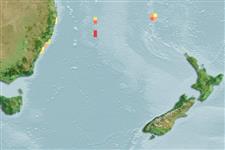>
Eupercaria/misc (Various families in series Eupercaria) >
Labridae (Wrasses) > Xyrichtyinae
Etymology: Novaculops: Latin, novacula = razor + Greek, ops = appearance (Ref. 45335); pastellus: Name from Latin word referring to colors that are soft and subdued..
More on authors: Randall, Earle & Rocha.
Environment: milieu / climate zone / depth range / distribution range
ນິເວດວິທະຍາ
ສັດທະເລ ກ່ຽວກັນຫີນ; ລະດັບຄວາມເລິກ 10 - 25 m (Ref. 78585). Subtropical
Southwest Pacific: Australia.
ຂະໜາດ / ນ້ຳໜັກ / Age
Maturity: Lm ? range ? - ? cm
Max length : 11.7 cm SL ຕົວຜູ້/ບໍ່ມີເພດ; (Ref. 78585); 10.6 cm SL (female)
Life cycle and mating behavior
Maturities | ການສືບພັນ | Spawnings | Egg(s) | Fecundities | ຕົວອ່ອນ
Oviparous, distinct pairing during breeding (Ref. 205).
Randall, J.E., J.L. Earle and L.A. Rocha, 2008. Xyrichtys pastellus, a new razorfish from the southwest Pacific, with discussion of the related X. sciistius and X. woodi. aqua, Int. J. Ichthyol. 14(3):149-158. (Ref. 78585)
IUCN Red List Status (Ref. 130435)
Human uses
ເຄື່ອງມື
Special reports
Download XML
ແຫຼ່ງອີນເຕີເນັດ
Estimates based on models
Phylogenetic diversity index (Ref.
82804): PD
50 = 0.5156 [Uniqueness, from 0.5 = low to 2.0 = high].
Bayesian length-weight: a=0.01023 (0.00397 - 0.02640), b=3.06 (2.84 - 3.28), in cm total length, based on LWR estimates for this (Sub)family-body shape (Ref.
93245).
ຊັ້ນເຂດຮ້ອນ (Ref.
69278): 3.4 ±0.4 se; based on size and trophs of closest relatives
ຄວາມຢືດຢຸ່ນ (Ref.
120179): ສູງ, ປະຊາກອນຕຳ່ສຸດທີ່ໃຊ້ເວລາສອງໜ້ອຍກວ່າ 15 ເດືອນ (Preliminary K or Fecundity.).
Fishing Vulnerability (Ref.
59153): Low vulnerability (10 of 100).
